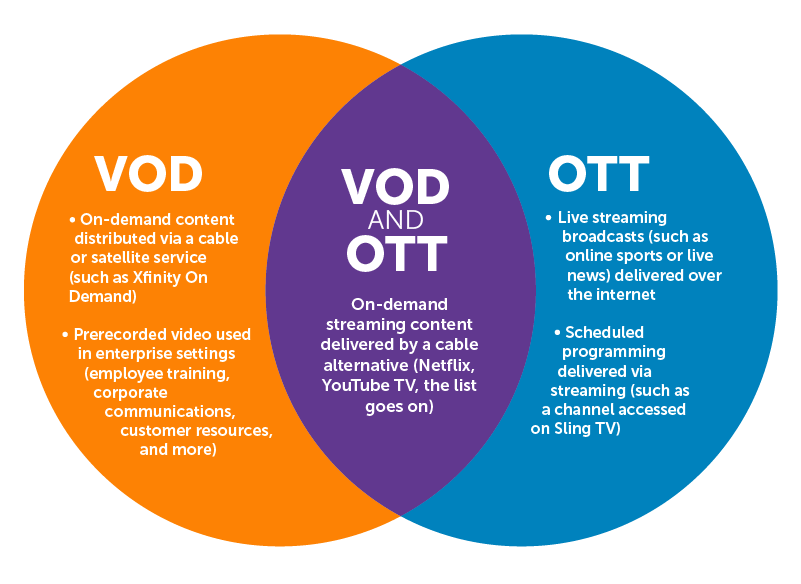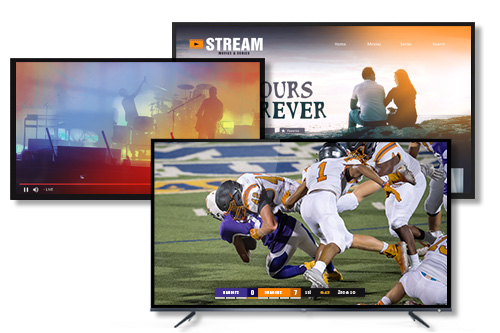VOD Streaming: What It Is and How It Relates to OTT (Update)
July 3, 2021
YouTube brought vlogging to the masses in the early 2000s with VOD streaming. And just a couple years after that, Netflix changed the entertainment industry forever by introducing VOD movie delivery.
Thanks to these streaming giants, video on demand (VOD) is what most people think of when they hear the word ‘streaming.’ But not all video content delivered online falls in the category of VOD streaming.
So, what is VOD and why does it matter? Buckle up, you’re in for a long ride.
Table of Contents
- What Is VOD Streaming?
- VOD vs. OTT: What’s the Difference?
- Live Streaming + VOD: A Winning Combination
- Monetization Models for VOD
- What to Look for in a VOD Provider
- How to Stream VOD With Wowza
What Is VOD Streaming?
VOD describes click-to-play video content that’s available without the constraints of a broadcasting schedule. With VOD, convenience is key. Viewers can choose what they want to watch, where they want to watch it, and when. As such, VOD streaming is never live, nor does it require a physical copy of the content being viewed (as with DVDs or Blu-ray Disks).
Due to last year’s social distancing mandates, VOD took over. Trolls World Tour, Mulan, and countless other would-be theatrical release went ‘direct to VOD’ as theaters closed their doors. Not only were viewers able to skip a trip to the box office or Redbox kiosk; they were able to stream these movies at their leisure rather than as dictated by static showtimes.
Today, VOD almost exclusively refers to content that’s distributed to viewers via streaming on internet-connected devices. However, downloaded files and recorded DVR content can also fall into this category.
YouTube’s David After Dentist and Netflix’s Tiger King are both prime examples of VOD content — the former being AVOD and the latter SVOD. Even so, VOD isn’t restricted to the media and entertainment industry. Doctors-in-training now rely on VOD streams of surgeries to further their education, while enterprises leverage on-demand streaming for everything from employee training to customer education.
VOD vs. OTT: What’s the Difference

For anyone familiar with over-the-top (OTT) media delivery, you might be asking: What’s the difference between VOD and OTT?
VOD is not synonymous with OTT — even if the platforms pictured above can be classified as both. Let’s define the two before getting into the details.
- OTT broadcasting describes media content delivered over the internet rather than via traditional cable and satellite services. Top players in the OTT space include Netflix, Disney+, Amazon Prime, Hulu, and Sling. Internet radio and VoIP services like WhatsApp also count as OTT because they bypass traditional broadcasting alternatives.
- VOD is any video content that starts when you push play — without requiring a physical DVD and player to initiate the process. Netflix, et al. fall in the category of VOD streaming, as do social media sites like YouTube and Facebook. Because the ‘V’ in VOD stands for ‘video’, pure audio content that’s provisioned similarly is instead described as audio on demand (AOD).
In many cases, VOD and OTT overlap, but not always. That’s because OTT describes the distribution model (video content delivered over the internet), whereas VOD describes the consumption model (video content that can be played back on demand). What’s more, OTT deals with consumer-facing media services, while VOD spans all industries and sectors. Finally, VOD is never live, which we’ll explore further in the next section.

Examples of Content Across the VOD to OTT Spectrum
The Mandalorian: VOD and OTT
Any on-demand video content delivered via streaming services like Hulu, Disney+, or Amazon Prime would be an example of both VOD and OTT. Let’s take The Mandolorian as our example here. It counts as VOD because viewers can access it on demand. Similarly, because Disney released the space western on their Disney+ streaming service rather than on their cable channel, it’s also a prime example of OTT.
The Super Bowl (Streamed Live): OTT
For the 5.7 million average viewers per minute who streamed Super Bowl LV via FuboTV, Sling TV, and other live streaming services, OTT media delivery provided them access to the game. This type of content is clearly differentiated from VOD in that the live broadcast was constrained by a broadcasting schedule and therefore viewers were forced to watch it at the time of broadcast.
Zombie Kid Likes Turtles: VOD
The ‘I like turtles’ YouTube video has attracted nearly 70 million views since 2007 thanks to VOD. While the interview was originally broadcast over-the-air and live, it’s the recording of it that went viral. The clip is a perfect example of why VOD operates as many live content distributors’ secret weapon: It gives them more bang for their buck by opening up additional viewing opportunities after a live broadcast has ended.
Live Streaming + VOD: A Winning Combination
Live Streaming vs. VOD
Because VOD content can be played whenever the viewer chooses, it’s never live. Rather, VOD describes prerecorded content that internet-connected users can stream by request.
But that’s not to say that live streams can’t become VOD. And when it comes to monetization, recording live streams for additional broadcast opportunities is crucial.
We all know that live streaming delivers a level of urgency, authenticity, and engagement that can’t be replicated. However, recorded content gives internet-connected users the capability to stream by request — which yields a measure of convenience that can’t be beat.
The two needn’t be at odds, though. And that’s where live-to-VOD enters the picture.
Live-to-VOD
Live-to-VOD services enable broadcasters to repurpose live content and expand their audience as soon as the event has ended by redistributing a recording of the originally aired content. What’s more, the resulting VOD assets put end users in control of their viewing experience — something we’ve all come to expect — with the ability to instantly, play, pause, and rewind the recording.
Benefits of Live-to-VOD Services:
- Expands your audience. Broadcasters are able to reach additional viewers by offering recorded content from live events for playback later.
- Puts viewers in control. VOD gives viewers the power to play, pause, and rewind content at their convenience by accessing on-demand content or using an nDVR feature for immediate time-shifted playback.
- Monetizes on-demand content. Live-to-VOD capabilities can help boost ROI by enabling broadcasters to redistribute content using one of the monetization models below.
How to Configure Live-to-VOD With Wowza
A streaming software or service can be used to enable nDVR and Live-to-VOD capabilities — thereby ensuring that you get the most out of your content. Check out the video below for a quick tutorial using Wowza Streaming Cloud.
Monetization Models for VOD
Whether you’re redistributing a recorded event or releasing a movie directly to consumers, several strategies can be used to boost revenue using VOD. Let’s take a look at the most common models VOD offers for converting content into cash.

Subscription Video on Demand (SVOD)
SVOD stands for subscription video on demand, which includes any VOD service that provides unlimited access for a recurring fee.
Viewers elect to pay for subscription-based video due to the quality of content that services like HBO Go deliver, the freedom from commercial interruptions, and the ability to watch it outside of any schedule.
Services like Netflix have championed the SVOD model, where content access is restricted to subscribers — thereby ensuring recurring business revenue regardless of how much VOD content is streamed.
Ad-Based Video on Demand (AVOD)
AVOD stands for ad-based video on demand, which looks the most like traditional TV broadcasting in that it uses commercials and other advertising techniques to generate revenue.
Ad-supported VOD is the dominant model across the Asia-Pacific region. And unlike with traditional TV — where the content and ads come packaged together — internet streaming opens opportunities for user-specific advertisements based on the demographics of an individual viewer.
With so many streaming services now available, experts predict that ad-supported video will make a comeback, forcing Netflix and other OTT platforms to rethink their subscription-based monetization model. Consumers will likely grow frustrated with having to pay for multiple streaming subscriptions and select both free and hybrid services that balance subscription- and ad-generated revenue.
Transaction Video on Demand (TVOD)
TVOD stands for transactional video on demand, which describes pay-per-view streaming content that viewers access on an ad-hoc basis. To throw another acronym in the mix, TVOD is often reserved for PVOD, or premium video on demand. PVOD content includes highly anticipated boxing fights and cinematic releases.
While transactional video on demand is by far the least common, the recent global health crisis has shined the spotlight on it. A large percentage of the direct-to-VOD movie releases that made headlines during the pandemic were available behind a paywall as a one-time purchase.
What to Look for in a VOD Provider
So what’s needed to get in on the VOD streaming craze? Free platforms like Facebook, Instagram, and YouTube might be suitable for amateur video distribution, but you’ll want a professional streaming platform to implement VOD streaming for your business.
Here’s what to look for when comparing the top streaming platforms out there for professional VOD delivery.
- Adaptive Bitrate Streaming. If you’ve ever noticed the stream you’re watching adjust from a fuzzy picture to sharp focus in a matter of seconds, then you’re familiar with adaptive bitrate streaming (ABR). This functionality ensures the best video quality and viewer experience possible — no matter your end-user’s connection, software, or device. As such, ABR is essential when distributing high-quality VOD content, and something you’ll want to prioritize when selecting your streaming infrastructure provider.
- Transcoding and Processing for Multi-Device Delivery. If every viewer had a 4K home theater plugged into high-speed internet, delivering video content would be easy. But that’s not the case. Today’s viewers are out and about, accessing streams from a variety of devices. Different screens and varying internet speeds make video transcoding and processing essential. In addition to enabling adaptive bitrate streaming, these capabilities allow you to repackage content in non-standard container formats like AVI and WMV for reliable playback on any device. Choosing a VOD streaming platform like Wowza that offers protocol flexibility will ensure that your streams play back across a multitude of endpoints.
- Scalable, Reliable Delivery. Getting the most out of your VOD assets starts with seamless video delivery across the globe. One of the best ways to achieve this is with a content delivery network (CDN). CDNs offer the fastest, most reliable way to get your content in front of numerous viewers anywhere in the world. What’s more, they provide an extra layer of reliability through redundancy. When streaming with Wowza, Wowza Streaming Cloud service automatically leverages the Wowza CDN to accommodate global audiences of any size. Wowza Streaming Engine deployments can be combined with the Wowza CDN to deliver a highly integrated workflow.
- Security and Monetization. Security is essential to several of the monetization models detailed above. Why? Because unauthorized access to streaming content can compromise the revenue-boosting strategies of subscription and pay-per-view services. What’s more, when VOD assets are being used for non-entertainment purposes — such as for patient communications and diagnostics within a healthcare setting — protecting sensitive or private data is key. Authentication, encryption, and digital rights management (DRM) are all important security capabilities to look for in a VOD provider.
- Flexible Infrastructure Deployment. There’s no one-size-fits-all approach to deploying streaming infrastructure. Some broadcasters need to get up and running fast with a cloud-based deployment. For others, such as enterprise, government, and surveillance organizations tasked with keeping their VOD assets behind a firewall, a streaming server software like Wowza Streaming Engine might be a better fit. Regardless, you’ll want to find a VOD provider capable of accommodating your unique deployment needs.
- Live-to-VOD. If your primary broadcast is live, but you’d like the ability to instantly create VOD assets from your live streams, you’ll want to find a streaming platform that supports live-to-VOD streaming.
- Additional Functionality. Two other popular features when streaming VOD assets include:
- Multi-lingual captions, which ensures accessibility to a vast array of viewers; and
- The ability to publish pre-recorded videos as live, which allows content distributors to schedule simple and complex sequences of VOD assets in advance.
- Custom Solutions. Successful VOD delivery requires two things: reliable streaming infrastructure and a solutions-oriented partner. Whether you’re in need of strategic guidance, comprehensive functionality, or custom implementation, it’s a good idea to seek out providers that offer professional services to support your specific streaming needs.
How to Stream VOD With Wowza
With Wowza, content distributors are able to supplement traditional broadcasting services and open up new monetization opportunities by leveraging the right mix of VOD and live streaming. Adaptive bitrate streaming ensures the best quality possible for viewers on mobile devices, set-top boxes, and everything in between. Plus, our engineers stand ready to architect the best system possible for your ecosystem.
Regardless of the monetization model, we designed our software, services, and hardware to make live and VOD streaming work for your business. Wowza powers reliable video delivery for market leaders in industries ranging from media to healthcare. And by offering a full-service platform and customized solutions, we work with each customer to ensure their success.
In addition to the live-to-VOD feature in Wowza Streaming Cloud highlighted above, Wowza Streaming Engine makes it easy to stream VOD content to a wide variety of player technologies. And depending on your needs, the video streams can be stored locally or on remote storage solutions. Learn more in the video tutorial below.




